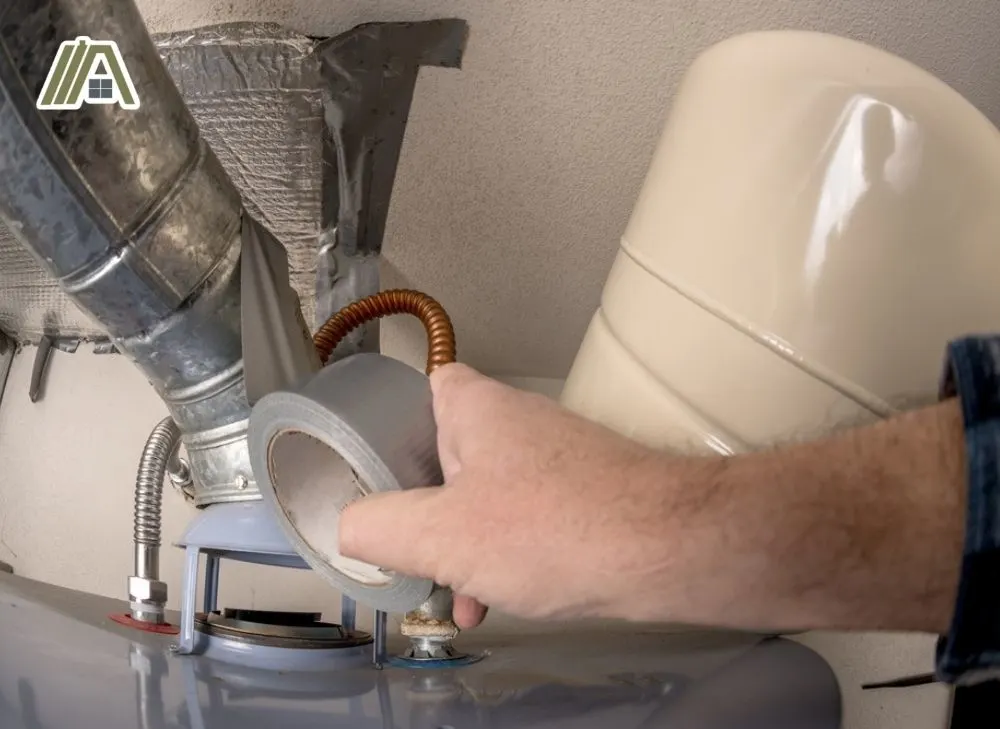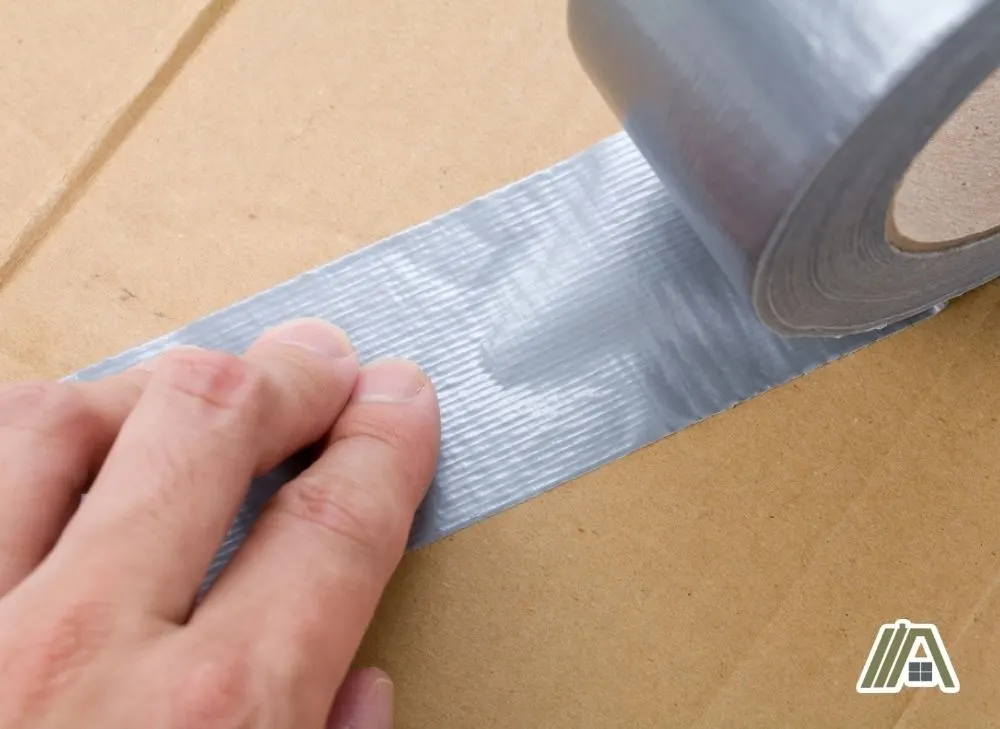
Duct tape refers to a category of cloth tape made by various companies that is typically used as a temporary "quick fix" around the house. Duck Tape is a brand that produces many different tapes, including a version of duct tape.
Difference Between Duct Tape and Duck Tape: Overview
Duct tape and Duck Tape can be the same thing. You will find that silver tape under both terms when you search for it.
However, they are not equivalent. This is because Duck Tape is a brand, a company (Duck®), that produces many different types of tape. They offer a version of duct tape, but the term is not mutually exclusive to it.
What is Duct Tape?
Duct tape is a silver cloth-based tape. This category of tape is made by many different companies like T-Rex and Gorilla, although the first duct tape was made by Johnson & Johnson for military use.
It came to be known as duct tape because it was once used on HVAC ducting, which is also where the silver color came from. However, using duct tape to seal ducting has been inappropriate for many years.

You likely think of duct tape in its silver form, but there are a variety of colors (from all brands) available to suit your needs. The tape has a plastic coating on the non-sticky side, giving it a synthetic feel and shine.
What It Is Made Of
Duct tape is composed of three layers: plastic, cloth, and adhesive.
The plastic layer is polyethylene, which is also used for bottles. This plastic layer helps hold everything together and adds some water resistance to the tape.
There is a fabric (typically low thread count), which is why the tape is cloth-based. This was added to the initial design to prevent shearing.
The cloth keeps the tape intact when you are pulling it off and contributes to its weight-bearing ability.
The adhesive is rubber-based. Rubber is mixed with resin to create the sticky layer of the tape. This adhesive also contributes to shear strength in the tape, but is not designed to last forever or stand against environmental exposure.
These are the basic components that make up duct tape, although the exact type and source of the material may differ between brands.
Limits/Uses
Duct tape is often misconstrued as the ultimate fix for anything. But in reality, there are several limitations that make the product less than ideal for some things or areas.
It is indeed a quick, simple, and strong solution to many handiworks, crafts, and repair situations. You will likely still find it very helpful for fixing tents, brooms, vacuum housings, hammer and screwdriver handles, and even some temporary first-aid, like splinting or bandaging.
You just need to keep in mind that anything you temporarily mend with duct tape will be marred by its residue.
If that is a problem aesthetically or if the residue will interfere with the permanent repair, I recommend giving it a miss. It’s one of the reasons that duct tape cannot be used as an alternative to electrical tape.
What duct tape is not appropriate to use on is anything HVAC-related (including ducts) and anything that requires a long-term, durable repair. This is because of how readily it is compromised by factors common to HVAC repairs and it is also why it not code-compliant.
The adhesive on duct tape suffers when exposed to the environment. The cold hardens it, making it brittle and unable to stick. The heat (140 ℉ and above) melts it, and UV light breaks down the bond with time.
The tape’s susceptibility to heat means that it is inappropriate for use in microwaves and dryers.
Prolonged exposure to moisture (even humidity) or submersion in water also loosens the glue’s grip.
The quality and material of the surface you stick the tape to also influences it; it sticks best and longest to clean, smooth surfaces.
Any dirt, oil, or unevenness prevents a firm bond. Low surface energy materials also prevent the glue from spreading and sticking.
Using duct tape on cardboard and painted or coated surfaces means that the tape adheres to the top layer. Therefore, if the fibers of the cardboard or layers of paint come off, so does the tape.

As you can see, duct tape is not appropriate for packaging, and you will have trouble using it on a couriered item.
What is Duck Tape?
Duck Tape is a brand of tape from the Duck Brand company. This brand makes a variety of tapes, including what we call duct tape.
Its name comes from one of the tape’s military nicknames and the fact that it originally used duck fabric or cotton duck. This was a heavy cotton (not made from real ducks) that looks a bit like a canvas material but has a tighter weave, although Duck doesn’t actually use this in their duct tape nowadays.
While people might generically refer to duct tape as Duck Tape, the latter is specifically a brand of tape instead of a category. This means that there is a range of tapes made from a variety of materials with differing appearances and properties that you can purchase from the Duck Tape brand.
What your Duck Tape looks like depends on what and where it is meant to be used. They offer electrical, double-sided, utility, and weather-resistant tape options, to name a few.
They even sell mini tape rolls that they call “Ducklings”, which is adorable.
The brand has several color options: bright, dark, transparent, etc., including silver, which Duck calls its duct tape color. You can also buy tape with printed designs, like animal prints or kittens (amazon link), along with many other patterns.
Limits/Uses
The uses and limitations of Duck Tape depend entirely on which tape you purchase. They have different characteristics that make them suitable for varying uses.
For example, the Utility Duck Tape has a temperature rating of 200 ℉, and there is a Clean Removal version of the Max Strength tape to help prevent residue when using the tape as a transient solution.
You must select the tape that best suits your needs for a particular project.
If you purchase Duck Max Strength Extreme Weather Duct Tape (amazon link). It is manufactured to withstand different temperatures, UV light, and water, and has a strong adhesive to allow you to perform long-lasting repairs in outdoor conditions.
You also have a Heavy Duty Packing Tape (amazon link) option, which can be used on boxes and packaging, unlike regular duct tapes.
Table of Differences Between Duct Tape and Duck Tape
| Duct Tape | Duck Tape |
| Duct tape is a category of cloth-based tape. | Duck Tape is a brand that produces many different tapes. |
| Duct tape is classically silver, but is available in multiple colors and different brands. | The appearance of Duck Tape products depends on which version and design you purchase. |
| Duct tapes are made of three layers: fabric, a polyethylene film, and a rubber (combined with resin) adhesive. | The composition of a Duck Brand tape differs across its ranges and categories. |
| Duct tapes can be used on a variety of things depending on your needs, but should not be used for permanent HVAC repairs and constructions. | Duck Tape is also versatile since you can buy a tape that suits your needs, including for electrical and sealing jobs. |
| Duct tapes are susceptible to wet, heat, cold, light, and uneven or unclean surfaces. | Duck Tape offers different tapes with a variety of characteristics that make them extra strong, easy to remove, weather-resistant, etc. |
Which Came First?
Johnson & Johnson’s cloth tape was the first of the “duct” tapes and is the origin of what you know today.
This tape was conceptualized by an ammunition factory worker named Vesta Stoudt in 1943, during World War II. Stoudt was looking for a hardy and waterproof tape to seal ammunition packages. So, she came up with the idea and design for this cloth-backed adhesive tape.
It was nicknamed “duck” tape by the WWII soldiers (although Stoudt may have given it the name) for its water resistance, or “100-mile-per-hour” tape, and ended up being used for everything from vehicle repairs to tents, to uniforms and boots.
While called “duck” tape by the soldiers, Johnson & Johnson named it “duct tape” when it was manufactured for and sold to civilians after the war. Duct tape became a general name for this type of tape.
Industrial tape was produced for many years by the lineage of companies that eventually started manufacturing duct tape, which became the trademark Duck Brand and “Duck Tape” in 1980.
Duck Tape Equivalent of Duct Tape
Along with the myriad of tapes that Duck produces, this includes duct tape.
Their standard duct tape is listed as The Original Duck Tape (amazon link).
It has the same fabric, plastic, and rubber-based adhesive layers as other duct tapes, sharing the same limitations. It is also designed for temporary use only, according to the brand.
Some gas stations with larger convenience stores will carry duct tape. However, they are unlikely to carry Duck Tape’s version.
Sources
https://www.jnj.com/our-heritage/vesta-stoudt-the-woman-who-invented-duct-tape
https://www.duckbrand.com/about
https://tapeuniversity.com/industry/building-construction/duct-tape-and-duck-tape/
https://www.echotape.com/blog/the-complete-technical-guide-to-duct-tape/
https://www.echotape.com/blog/complete-technical-guide-adhesive-tape/
https://www.duckbrand.com/products/duck-tape


